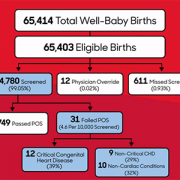Cardiology and heart surgery update: fetal magnetic resonance imaging, chest pain
July 20, 2016 – Utility of fetal magnetic resonance imaging in assessing the fetus with cardiac malposition
Abnormal cardiac axis and/or malposition can trigger an evaluation of fetuses for congenital heart disease. A research team led by Mary T. Donofrio, MD, director of the Fetal Heart Program at Children’s National Health System, sought to examine how fetal magnetic resonance imaging (fMRI) – might complement obstetrical ultrasound or fetal echocardiography (echo) – in defining etiology. The team reviewed 42 fetuses identified as having abnormal cardiac axis and/or malposition by fetal ultrasound and echo. While 55 percent of cases (23) had extracardiac anomalies, 29 percent (12) were reassigned by fMRI. fMRI findings were confirmed in 8 of these 12 cases postnatally.
June 13, 2016 – Targeted echocardiographic screening for latent rheumatic heart disease in Northern Uganda
Echocardiographic screening to detect latent rheumatic heart disease (RHD) has the potential to reduce the burden of disease, however additional research is needed to develop sustainable public health strategies. Some 33 million people, many living in low-resource environments, have RHD. What’s more, relatives of children with latent RHD may be at risk for developing the chronic heart condition. The research team found that siblings of children who were RHD-positive were more likely to have RHD, underscoring the importance of screening brothers and sisters of a child with confirmed RHD.
April 3, 2016 – Chest pain in children – the charge implications of unnecessary referral
While pediatricians are responsible for triaging chest pain complaints, questions linger about the best approach to reassure patients whose conditions are benign as well as how to best identify patients whose chest pain warrants further evaluation and testing. The study sought to assess how many patients with chest pain were inappropriately referred and found that chest pain due to cardiac disease is very rare in children. Thus, children whose chest pain is not accompanied by cardiac red flags can be managed safely by their pediatrician.
April 2, 2016 – Hemodynamic consequences of a restrictive ductus arteriosus and foramen ovale in fetal transposition of TGA
Dextro-transposition of the great arteries (d-TGA) occurs when the position of the main pulmonary artery and the aorta – the two main arteries that carry blood out of the heart – are switched. Newborns with d-TGA are at risk for compromise due to foramen ovale (FO) closure and pulmonary vascular abnormalities. One such fetus seen at 22 weeks of gestational age had a hypermobile, unrestrictive FO and small ductus arteriosus (DA) with bidirectional flow. By the 32 week, however, the DA was small with restrictive bidirectional flow. Doppler imaging showed reversed flow in the left pulmonary artery. By the 38th gestational week, the FO was closed, the left atrium/ventricle were dilated, and the DA was tiny. Within 30 minutes after birth, a balloon atrial septostomy was performed, and the infant later underwent surgical repair.











